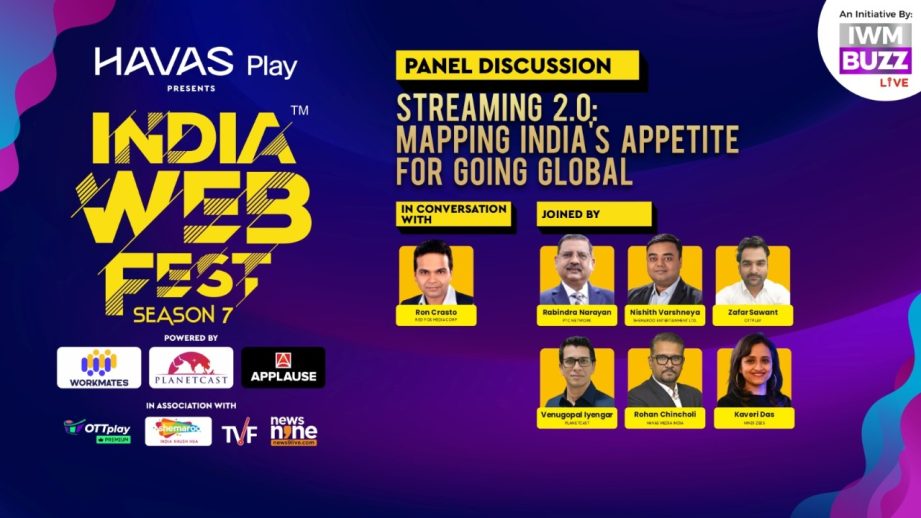
It’s time for us to cultivate stories that the world can hear. The stage was set for a conversation that felt both inevitable at the India Web Fest’s seventh season. The question at the heart of the panel discussion was deceptively simple: Why hasn’t Indian content travelled the world the way it should—and is that finally changing?
Moderated by Ron Crasto, Red Fox Media Corp, the session joined by, Rohan Chincholi, Havas Media India, Kaveri Das, Hindi ZEE5, Rabindra Narayan, PTC Network, Nishit Varshneya, Shemaroo Entertainment Ltd., Zafar Sawant, OTTplay and Venugopal Iyengar, Planetcast, brought together voices that sit at the intersection of storytelling, technology, and business, leaders from OTT platforms, networks, content aggregators, and tech providers. What emerged was a clear-eyed portrait of an industry in transition. And for once, the word “global” didn’t feel like a marketing aspiration. It felt like direction.
Global Appeal Needs Universal Themes Rooted In Local Culture
The globally accepted Indian cinema shall have stories that are deep in the Indian local setup but shall touch upon universal human experiences and conflicts. This method of “hyper-locality with universality” is akin to successful Korean and Turkish content strategies, making Indian stories relatable beyond just the diaspora.
OTT Platforms Are Catalysts For Globalisation
The rise of OTT platforms has reduced the clout of the conventions of content in Indian cinema, such as song sequences and star-centric narratives. Flexible formats of OTT encourage experimentation with different genres and narratives meant to attract a global audience, so content creators must think big and break away from traditional conventions.
Technology Behind The Scene
The panel emphasised content, but it also laid emphasis on the technology behind globalisation.
Dubbing, subtitling, voice cloning, and automated QA checks are some forms of AI technology that drastically diminish the time and costs required for international content distribution. However, now that they are there to improve efficiencies, strong storytelling becomes important-even good technology can only help to strengthen it, said Venugopal Iyengar of Planetcast. As such, it was unanimously agreed that technology may power distribution, but not instinct, voice, or cultural knowledge.
The Balancing Act- Hybrid Models For A Multi-Kaleidoscopic Indian Streaming Audience
The monetisation discussion took a practical turn, stating that. In contrast, the subscription-based model or SVOD is steadily gaining popularity, especially among metros and global viewers; the ad-based model or AVOD has so far been able to penetrate India the most. It is generally the Indian consumer’s lack of habit to pay for any content that leads to a preference-based free content system, although this stance seems to be evolving. The general agreement was aligned in favour of a hybrid model; one that is balanced in consideration of a varied audience-Certain sections would pay for an ad-free premium content, while others would gladly watch ads for the entertainment they get in return.
Niche Is No Longer Niche
What’s often called “niche”—Indian folklore, kabaddi and jallikattu as regional sports, oral histories, and local legends—these are increasingly being seen as the last great reservoirs of content. The panellists argued that these are not the dead culture left for occasional record; instead, they are budding categories of content that have the actual potential to grow. Meanwhile, that interest is rising globally, most notably from diaspora communities, but also among various audiences in search of authenticity. The clear message was that good storytelling doesn’t have to be sacrificed to resonate—it has to be genuinely well told.
Data Is The New Compass
In a world where choice is too ample, one cannot say that how content is discovered matters less than how it is created. Data-driven might be the word for decisions regarding language, format, or release timing, from commissioning to marketing.
Particular mention was made of the African markets, where Indian content is thriving through dubbing, considering the deep Indian heritage in these countries, along with unexpected insights from the Middle East, where genre preferences vary widely from one platform to another. This is not about numbers but about nuances.
The Future of Indian Content Is Borderless
Panellists agreed that, in the future, Indian films will lose their nationality tag and will be consumed as global or world cinema. The blurring lines between what is regional, national, and international denote the growing presence of a world entertainment ecosystem, where stories are free from their place of origin.
The Takeaway
The panel didn’t suggest that Indian content has “arrived.” Instead, it argued that it’s finally on the right path—backed by open platforms, technology that is enabling, and creators who are no longer afraid to speak in their own language, literally and figuratively.
The world is watching. And for the first time in a long time, Indian content isn’t just being seen—it’s being heard.
